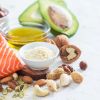How I Lowered My Cholesterol with a Heart-Healthy Diet
Like many people, I didn't pay much attention to my cholesterol levels until I was told by my doctor that they were higher than normal. The news was a wake-up call, especially when I learned that elevated cholesterol can increase the risk of heart disease and stroke. At that point, I knew I needed to make a change. After a lot of research and trial and error, I discovered that a heart-healthy diet could be one of the most effective ways to lower my cholesterol and improve my heart health. I want to share my journey and the steps I took to reduce my cholesterol naturally with the help of food and lifestyle changes.

1. Understanding Cholesterol and Its Impact on Your Health
Cholesterol is a fatty substance found in your blood that plays a role in building healthy cells. However, when you have high levels of low-density lipoprotein (LDL), often referred to as "bad cholesterol," it can build up in your arteries, leading to heart disease and other cardiovascular issues. On the other hand, high-density lipoprotein (HDL), known as "good cholesterol," helps carry cholesterol away from your arteries, reducing the risk of plaque buildup.
Before making any dietary changes, it’s important to understand where your cholesterol levels stand. A simple blood test, which measures total cholesterol, LDL, HDL, and triglycerides, can give you a clear picture. I was surprised when my results showed elevated LDL levels and low HDL levels, which was a sign that I needed to take action. While genetics and other factors play a role in cholesterol, diet is one of the most powerful tools to manage and improve your cholesterol levels.
Atlanta Heart Specialists
atlanta heart specialists
4375 Johns Creek Pkwy #350, Suwanee, GA 30024, USA

2. Choosing Heart-Healthy Foods: The Key to Lowering Cholesterol
When I started to research how to lower my cholesterol through diet, I learned that certain foods could help reduce LDL cholesterol and improve heart health. Here are some key food groups that I incorporated into my daily routine:
Soluble Fiber
One of the first changes I made was adding more fiber-rich foods to my diet. Soluble fiber binds to cholesterol in the digestive system and helps remove it from the body. Foods like oats, barley, beans, lentils, apples, and carrots are rich in soluble fiber. I began starting my day with a bowl of oatmeal and added beans to my salads and soups. Not only did I enjoy the health benefits, but I also felt fuller for longer, which helped with managing my weight—a bonus for heart health.
Healthy Fats: Avocados, Nuts, and Olive Oil
Although fats often have a bad reputation, I learned that not all fats are created equal. Healthy fats, like monounsaturated and polyunsaturated fats, can help lower LDL cholesterol and raise HDL cholesterol. I made it a point to include avocados, nuts (especially almonds and walnuts), and olive oil in my meals. These healthy fats not only taste great but also provide heart-healthy benefits. I swapped out butter for olive oil and added a handful of nuts to my snacks or salads. It was a simple swap, but it made a huge difference in my cholesterol levels.
Fatty Fish
Fatty fish like salmon, mackerel, and sardines are rich in omega-3 fatty acids, which are known to reduce triglyceride levels and improve heart health. I started eating fatty fish at least twice a week and noticed a difference in how I felt. Omega-3s have anti-inflammatory properties that benefit the heart, and I felt more energized after incorporating these fish into my diet. If you’re not a fan of fish, omega-3 supplements are also available, but I personally prefer getting my nutrients directly from food sources.
Plant-Based Proteins
Another significant change I made was reducing my intake of red meat and replacing it with plant-based proteins. Foods like tofu, tempeh, and edamame are great sources of protein that don’t contribute to raising cholesterol. I started experimenting with plant-based meals like stir-fries and grain bowls. These foods provided the protein I needed while being heart-healthy and cholesterol-friendly. Cutting back on meat not only helped my cholesterol but also supported my overall health.
3. The Power of Antioxidants: Fruits and Vegetables
Fruits and vegetables are essential for a heart-healthy diet. They’re packed with vitamins, minerals, and antioxidants that help protect the heart and lower cholesterol. I made it a habit to fill half of my plate with vegetables at each meal, focusing on a colorful variety of produce. Dark leafy greens like spinach, kale, and broccoli are particularly beneficial for lowering cholesterol due to their high fiber content and antioxidants.
One of my favorite meals became a big salad with a variety of colorful veggies, topped with a simple olive oil and lemon dressing. Not only was it tasty, but it also helped me reach my daily vegetable intake goals. I also started incorporating more fruits like berries, citrus fruits, and apples, all of which are high in fiber and antioxidants. Berries, in particular, are known for their ability to help improve heart health, and I loved adding them to my smoothies or enjoying them as a snack.
4. Reducing Unhealthy Foods: The Impact of Sugar and Trans Fats
While adding heart-healthy foods to my diet, I also needed to eliminate or cut back on certain unhealthy foods. One of the biggest culprits in raising cholesterol is trans fats, which are often found in processed foods, baked goods, and margarine. These fats not only raise LDL cholesterol but also lower HDL cholesterol, making them especially harmful to heart health. I started reading food labels more carefully and made it a point to avoid foods with hydrogenated oils or trans fats.
Another area I focused on was reducing my intake of refined sugars and carbohydrates. Excess sugar consumption can raise triglyceride levels and lead to weight gain, both of which negatively impact heart health. I found that cutting back on sugary snacks, soda, and processed foods helped me maintain better control over my cholesterol and kept my weight in check. Instead of sugary snacks, I started opting for whole grains and natural sweeteners like honey or maple syrup in moderation.
5. Lifestyle Changes: Exercise and Weight Management
In addition to making dietary changes, I found that incorporating regular exercise into my routine was essential for improving my cholesterol levels. Exercise can help raise HDL cholesterol and lower LDL cholesterol, and it’s especially effective at improving heart health. I started exercising at least 30 minutes a day, focusing on a combination of aerobic exercises like brisk walking, cycling, and swimming.
Along with exercise, managing my weight became a priority. Carrying excess weight, especially around the abdomen, can contribute to higher LDL cholesterol and triglyceride levels. By following a heart-healthy diet and staying active, I was able to lose weight gradually and see significant improvements in my cholesterol levels. This combination of diet and exercise worked wonders for my overall health and energy levels.
6. Regular Checkups and Monitoring Your Progress
Throughout my journey to lower my cholesterol, I made sure to schedule regular checkups with my doctor to monitor my progress. Blood tests are essential for tracking your cholesterol levels, and they allow your doctor to see how your diet and lifestyle changes are affecting your health. It’s important to work closely with your healthcare provider to develop a plan that’s tailored to your specific needs. They can help guide you through dietary recommendations, exercise plans, and other lifestyle changes that will help improve your cholesterol.
By keeping track of my cholesterol levels, I was able to stay motivated and make adjustments as needed. It was incredibly rewarding to see my LDL cholesterol decrease and my HDL cholesterol increase as I continued to implement these changes.
If you're looking for support in lowering your cholesterol or improving your heart health, I recommend checking out HeartCare Hub, where you can find expert advice, resources, and healthcare services tailored to your needs. With the right diet, exercise, and lifestyle changes, lowering your cholesterol is entirely within reach.





















Deborah Heart and Lung Center
deborah heart and lung center
200 Trenton Rd, Browns Mills, NJ 08015, USA